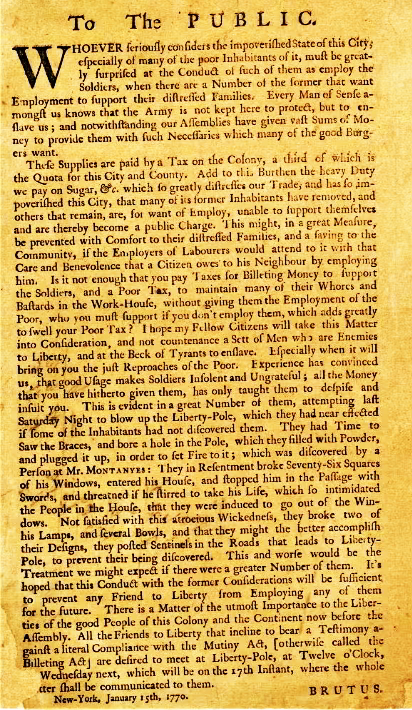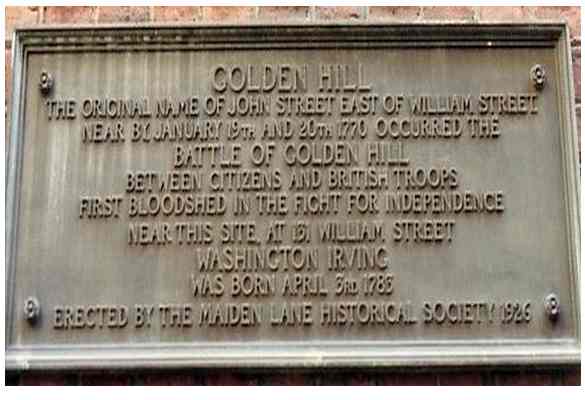January 14, 2024 at 2:11 a.m.
Golden Hill Riot
New Yorkers and Bostonians have a number of things to dispute—Yankees versus Red Sox, Manhattan versus New England clam chowder, good or bad memories of the Super Bowl in 2008 and 2012. We will avoid adding, “Where was the first blood of the American Revolution shed?” as another. When most people are pressed to remember clashes with the British prior to the Revolution, the answer is typically the Boston Massacre; but before that bloody day, there was the Golden Hill Riot in New York City on January 19, 1770.
The contretemps could also be called the Battle of the Liberty Poles. During the imperial crisis with Britain in the 1760s, the Sons of Liberty in New York City sometimes erected "Liberty poles" to symbolize their displeasure with British authorities. The first such pole was put up in City Hall Park on May 21, 1766, in celebration of the repeal of the 1765 Stamp Act. The presence of the British troops in the city in the years that followed became the real provocation for the bloodshed. Resentment against the quartered soldiers had several sources: New Yorkers were not only offended by their behavior and opposed the political dealing that forced them to pay for the military presence, but they also objected to the troops’ competition in the labor force. Off-duty soldiers were permitted to take odd jobs in the city and did so at low wages.
The British hated this pole and chopped it down in August in protest of the fact that the New York government had refused to enforce the Stamp Act. Another pole was put up which was quickly cut down. A third pole was put up which stayed up until 1767 when British soldiers cut it down after seeing colonists celebrating the anniversary of the repeal of the Stamp Act. A fourth was put up this time secured with iron bands. In 1767, the Quartering Act was passed which the New York government mostly left unenforced. Parliament reacted to this by dissolving the assembly and replacing it with one that did agree. The Sons of Liberty posted a broadside called “To the Betrayed Inhabitants of the City and Colony of New York” in response. The British blew up this liberty pole on January 16 because of the broadside and as a result of the fact soldiers were given 1800 pounds for supporting the act. They left the remains of the pole on the door of a tavern owner named Mr. Montanye. The "red coats" also posted their own handbills which attacked the Sons of Liberty as "the real enemies of society" who "thought their freedom depended on a piece of wood".
Meanwhile, dissatisfaction was expressed in published circulars (librarians call these “broadsides”) distributed and posted on the streets. Rare surviving examples include “Brutus”—quite likely Alexander McDougall—demands to know how city inhabitants could employ off-duty soldiers, here only “to enslave us,” while local laborers are impoverished.  The reply from the 16th Regiment of Foot begins with a piece of seventeenth-century verse lamenting the fate of the unappreciated soldier, but the poetry was followed by a pungent attack on the Sons of Liberty who defame the troops and act as though freedom depended upon “a piece of wood.” This war of the broadsides led directly to the armed confrontation between civilian activists and redcoats.
The reply from the 16th Regiment of Foot begins with a piece of seventeenth-century verse lamenting the fate of the unappreciated soldier, but the poetry was followed by a pungent attack on the Sons of Liberty who defame the troops and act as though freedom depended upon “a piece of wood.” This war of the broadsides led directly to the armed confrontation between civilian activists and redcoats.
On January 19, 1770, six weeks before the Boston Massacre, Isaac Sears and others tried to stop some soldiers from posting handbills at the Fly Market at the foot of Maiden Lane. Sears captured some of the soldiers and marched his captives toward the mayor's office, while the rest of the British soldiers ran to the barracks to sound the alarm. A crowd of townsfolk arrived along with a score of soldiers. The soldiers were surrounded and badly outnumbered. Fellow soldiers tried to rescue them but were ordered back to their barracks. As they were being escorted to their barracks, they reached John Street between William Street and Pearl Street. This area was known as "Golden Hill", after a nearby wheat field.
An officer then said, “Soldiers, draw your bayonets and cut your way through them." As more soldiers appeared with drawn bayonets, they were ordered to their barracks by Mayor Whitehead Hicks. A crowd followed them until the troops met with reinforcements on Golden Hill, along present-day John Street. There were no deaths in the ensuing chase and scuffle, but both sides sustained injuries. These included bayonet stabbings and attacks on a couple of uninvolved civilians.
This event made Alexander McDougall famous in the area and later a general in the Continental Army. Now hoping to give the Liberty Pole an official imprimatur, a committee led by Alexander McDougall, Isaac Sears, and John Lamb appealed to the city to erect a fifth pole on city ground. When their request was denied, Sears purchased a lot even closer to the barracks, and his comrades erected a pole forty-six feet long, embedded twelve feet deep and bound with iron bars and hoops - raised on February 6, 1770. This one survived until the British occupied New York City in the fall of 1776.  Though the event was not as famous as the Boston Massacre, it was remembered in 1898 with a plaque on the site of the battle, in current day Eden's Alley. However, the building was demolished, and the plaque disappeared
Though the event was not as famous as the Boston Massacre, it was remembered in 1898 with a plaque on the site of the battle, in current day Eden's Alley. However, the building was demolished, and the plaque disappeared





Comments:
You must login to comment.